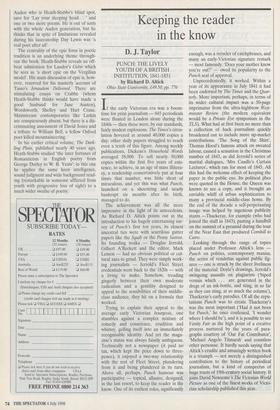Keeping the reader in the know
D. J. Taylor
PUNCH: THE LIVELY YOUTH OF A BRITISH INSTITUTION, 1841-1851 by Richard D. Altick Ohio State Uuniversity, £49.50, pp. 776 If the early Victorian era was a boom- time for print journalism — 845 periodicals were floated in London alone during the 1840s — then these were, by our standards, fairly modest explosions. The Times's circu- lation hovered at around 40,000 copies a day; other daily papers struggled to reach even a tenth of this figure. Among weekly publications, Dickens's Household Words averaged 38,000. To sell nearly 50,000 copies within the first five years of exis- tence, to achieve, in an age of mass illitera- cy, a readership conservatively put at four times that number, was little short of miraculous, and yet this was what Punch, launched on a shoestring and nearly bankrupt six months after its birth, managed to do.
The achievement was all the more impressive in the light of its antecedents. As Richard D. Altick points out in the introduction to his hugely entertaining sur- vey of Punch's first ten years, its closest ancestral ties were with scurrilous gutter papers like the Squib or the Penny Satirist. Its founding troika — Douglas Jerrold, Gilbert A'Beckett and the editor, Mark Lemon — had no obvious political or cul- tural axes to grind. They were simply work- ing journalists — Jerrold's Fleet Street credentials went back to the 1820s — with a living to make. Somehow, treading gingerly between their own moderate radicalism and a gentility designed to appeal to the sensibilities of their middle- class audience, they hit on a formula that worked.
Trying to explain their appeal to the average early Victorian bourgeois, one stumbles against a complex mixture of comedy and conscience, erudition and whimsy, gelling itself into an immediately recognisable identity. And yet the maga- zine's status was always faintly ambiguous. Technically not a newspaper (it paid no tax, which kept the price down to three- pence), it enjoyed a two-way relationship with the rest of Fleet Street, plundering from it and being plundered in its turn. Above all, perhaps, Punch humour was participative — topical, allusive, designed, in the last resort, to keep the reader in the know. One of its earliest roles, significantly enough, was a recycler of catchphrases, and many an early-Victorian signature remark — most famously, 'Does your mother know you're out?' — owed its popularity to the Punch seal of approval.
Unprecedentedly, it worked. Within a year of its appearance in July 1841 it had been endorsed by The Times and the Quar- terly. More important, perhaps, in terms of its wider cultural impact was a 50-page imprimatur from the ultra-highbrow West- minster Review (the modern equivalent would be a Private Eye symposium in the TLS). What had at first been no more than a collection of hack journalism quickly broadened out to include more up-market contributions. 'The Song of the Shirt', Thomas Hood's famous attack on sweated labour, caused a sensation in the Christmas number of 1843, as did Jerrold's series of marital dialogues, 'Mrs Caudle's Curtain Lectures', which ran for most of 1845. All this had the welcome effect of keeping the paper in the public eye. Its political jibes were quoted in the House, the Queen was known to see a copy, and it brought an enviable whiff of urban sophistication to many a provincial middle-class home. By the end of the decade a self-perpetuating image was helped by ingenious publicity stunts —Thackeray, for example (who had joined the staff in 1843), pasting a handbill on the summit of a pyramid during the tour of the Near East that produced Comhill to Cairo.
Looking through the range of topics placed under Professor Altick's lens Punch on politics, contemporary manias, the series of vendettas against public fig- ures — one is struck by the sheer liveliness of the material: Doyle's drawings, Jerrold's swingeing assaults on plagiarists (`biped vermin which . . . are generated in the dregs of an ink-bottle, and sting, in so far as they can sting, at so much the column'), Thackeray's early parodies. Of all the repu- tations Punch was to create Thackeray's was the most important (`flad it not been for Punch,' he once confessed, 'I wonder where I should be'), and it is possible to see Vanity Fair as the high point of a creative process nurtured by the years of para- graphs courtesy of 'Our Fat Contributor', `Michael Angelo Titmarsh' and countless other personae. It hardly needs saying that Altick's erudite and amusingly written book is a triumph — not merely a distinguished contribution to the history of periodical journalism, but a kind of conspectus of huge tracts of 19th-century social history. It joins David Newsome's The Victorian World Picture as one of the finest works of Victo- rian scholarship published this year.














































































































 Previous page
Previous page